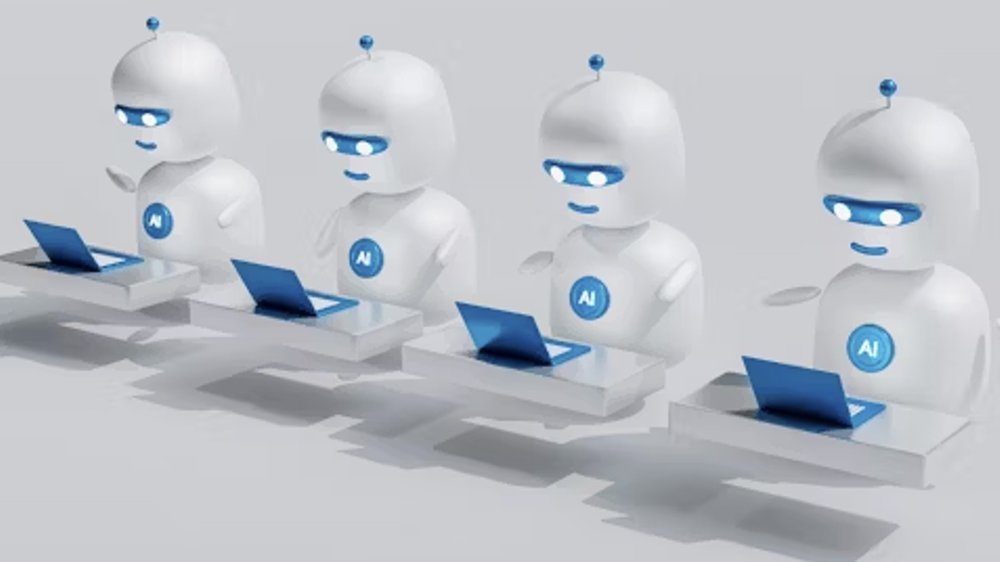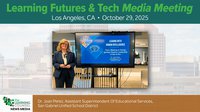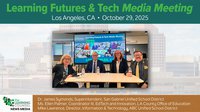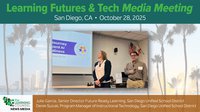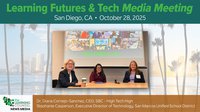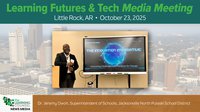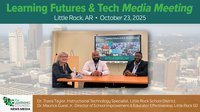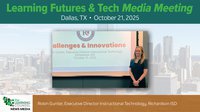I have had the privilege of serving as an educator in Wisconsin’s Verona Area School District for over 37 years, working closely with the staff, students, parents and community members to thoughtfully integrate technology into the classrooms. As the Educational Technology Coach, I support teachers by modeling innovative strategies, co-planning and co-teaching lessons, curating research, analyzing student usage data, and employing many other strategies. In recent years, I have also embraced the use of artificial intelligence (AI) to enhance my coaching practices and address key challenges that teachers face.
Beyond my role as a coach, I have had the opportunity to present at various conferences and host webinars on artificial intelligence (AI) sharing insights with a wide range of audiences, including educational leaders, teachers and administrative assistants. These experiences allow me to highlight best practices for integrating AI into schools, empowering educators to leverage the potential of this transformational technology. My focus is on practical applications of AI that enhance teaching and learning, streamline administrative tasks and foster innovative practice that actively engage students.
Recently I had the privilege of helping test enhancements to the AI-powered assessment generator within Discovery Education Experience. This experience, a new step in my ongoing journey in educational technology taught me five key lessons about integrating AI-powered classroom tools - insights I believe all educators should know. Here’s what I learned:
- Start Small and Use Tools with a Purpose
The world of AI in education is vast, with tools designed to save time, personalize learning, and even act as thought partners. From automating tasks like grading and generating differentiated lesson plans to quickly creating worksheets, images or translating documents, it’s easy to be excited, dive in and lose focus. When I first explored AI tools, I felt overwhelmed. I would log into one tool to create images, use another to make rubrics, and then sift through shared spreadsheets from friends, testing out other tools. It felt chaotic. When I introduce AI tools to others, I see the “wow” factor - participants are amazed by the vast potential these technologies offer. However, it is equally important that before diving in, ask yourself: “What specific challenge am I trying to solve?” How will this benefit my students or me? By starting with a purpose, you will have a clear vision that ensures that your use of AI is intentional and aligned with your goals.
- Collaborate with Other Colleagues
It can be overwhelming to try to navigate the ever-evolving AI landscape without support. Working with colleagues to test and implement AI tools can be effective, rewarding and even fun. Collaborating with colleagues allows you to share best practices, exchange valuable insights and explore how these tools can be used across grade levels and in various content areas. Collaboration fosters diverse perspectives enabling you to have conversations about creative ways to use AI-powered tools. Personally, I have found that planning and using the tools with colleagues allows for a deeper understanding of the tools and I gain valuable insights and try features that I would never have noticed on my own.
3. Ensure Student Data and Privacy
Before utilizing any AI tools, it is important that you consult with your District personnel and/or Director of Technology to ensure that they are approved for staff use and comply with district policies. When using tools with students, it is equally important to ensure that student data privacy is being upheld. Many tools use uploaded data to continue to improve and refine their algorithm and features. Taking time to understand how the tool collects, stores and uses the data that is being uploaded helps ensure that you are making informed decisions that align with your district’s policies.
4. Understand the Limitations of Keeping Equity at the Forefront
No AI tool is perfect. I have used many tools only to discover that the data being analyzed is sometimes inaccurate. I recall one of my first experiences analyzing over 800 songs submitted by students for a high school Homecoming dance. I asked AI to analyze the top 30 most requested, school-appropriate songs, but the tool repeatedly included “Happy Birthday.” When I responded “I don’t think that is correct," the AI responded, “You’re right, sorry.” This example highlights a common issue with many AI tools: hallucinations, or the generation of faulty information. Additionally, because most AI tools are trained using standard English, it’s critical to recognize the potential biases and limitations they may produce. You are the expert on the content, so always verify AI-generated outputs for accuracy to ensure you don’t inadvertently perpetuate inaccuracies or biases.
5. AI Tools are Rapidly Advancing and have the Potential to Transform Education
There is no doubt that AI tools are here to stay, and their capabilities are evolving at an unprecedented pace. I can’t imagine going back to how I was creating lesson plans or designing curriculum prior to being introduced to many of these AI tools. Each day brings new ways that they can help change and enhance the educational landscape. What these tools were unable to do just months ago, they can now do at greater speeds and precision. AI’s ability to support diverse learning needs means that it has the potential to help all learners. I believe we are at a pivotal moment in education and with the collective knowledge and guidance from educators around the world, we have the opportunity to truly transform education. By leveraging AI effectively, we can ensure that each learner gets the support they need to be successful!
About the author
Rita Mortenson is the Educational Technology Coach for Verona Area High School, in Verona, Wisconsin. She is an ISTE Certified Educator, Discovery Education Advisory Council Member, Apple Distinguished Educator, Google Certified Innovator, and is a National Board Certified Teacher. She enjoys working and collaborating with staff and students to create opportunities for all.

